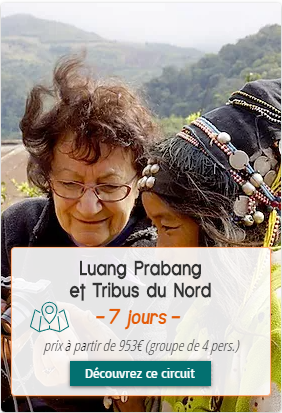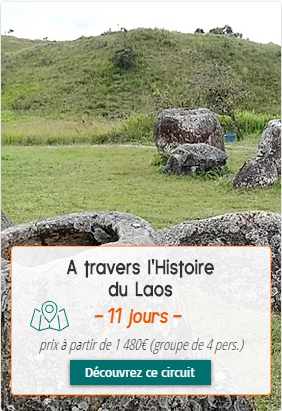Luang Prabang in Figures - All the answers to your questions about this charming town
Dernière mise à jour : 7 juil. 2023

For several years now, our team at ORLA TOURS has been in the habit of informing you with cultural, ethnic, technical and informative articles to help you prepare for your trip to Laos.
As our offices are located right in the center of Luang Prabang, we thought it would be a good idea this month to tell you more about this city, which receives over 450,000 visitors a year (2019).
Here's our article on this charming city, listed as a UNESCO World Heritage Site since 1995.
Enjoy your reading!
Biography of the town where our travel agency has decided to set up business
Luang Prabang is located in northern Laos. It was the royal capital of the Kingdom of the Million Elephants, known in Lao as Lane Xang, from 1353 until 1945, on April 8 to be precise, when Laos gained its independence under King Sisavang Vong.
When you visit Luang Prabang, you'll be able to see for yourself this journey back in time, thanks to the architecture of the houses, temples and customs that remain unique and specific to this city.
Luang Prabang is home to just over 55,000 inhabitants, spread over an area some 10 kilometers long and 5 kilometers wide, with a total provincial surface area of 236,800 km². Luang Prabang lies at an altitude of over 300 metres in the city center, rising to 400 metres at its highest point, Mount Phousi.
Located 385 kilometers from Vientiane (7 hours 30min by car or 10 hours by bus, day or night), it is the country's third-largest city, but remains the most authentic.

Cultural immersion and encounter with the most beautiful temples
This little corner of paradise, where Buddhist culture is very much alive, boasts some 40 temples. The oldest still in use is Vat Visoun (Vat Visounnarat), built in 1513. Vat Xieng Thong, built in 1560, is equally impressive, with its golden façade illuminated at sunset.
As you'll see, each of Luang Prabang's temples has its own charm and ambience, and you'll never tire of it. Admission to some temples costs 20,000 kip (around 2 euros). Profits go towards restoring them. Other temples are still free, but you'll have to leave the peninsula to visit them.
On the day of your visit to the temples, don't forget to wear something to protect your legs and shoulders. A long skirt or Sine, the traditional Laotian skirt, for women and long pants for men. Indeed, it's impolite to show up in beachwear (or almost) in a place that is sacred to the Laotians.
To give you a guideline, your knees and shoulders should not be visible. Don't forget your camera, as the temples of Luang Prabang are quite something! It's not unusual to come across a local ceremony where monks are drumming or reciting Buddhist texts typical of Luang Prabang, which may differ from those in Vientiane, for example.
Discover Luang Prabang's local markets
Scattered throughout the city you'll find a dozen markets of all sizes, such as the morning or "Talad Tha Huea Mé" market, the "Phousi" market, the "Phouven" market, the "Dara" market... each with its own specialities.
The Phousi market is very large and devoted to fruit and vegetables, fresh fish and clothing. You'll also find cutlery makers. It's open all day and closes around 5 p.m.
The Phouven market offers the same products, but is unique in that it also sells wild animals for cooking. You'll find fish, crustaceans and Mekong stingrays, depending on the season, as well as snakes, rats, insects and more. It's open all day for the clothing section, and from 4pm for the "wild" and food sections.
You'll see for yourself that local Laotian markets aren't as aseptic as in Europe. Pieces of meat are laid out on wooden tables, and vendors swat away flies with bags attached to sticks. A word of advice: remember to wash your meat well before cooking it if you're shopping there.

Tourism figures, number of visitors, hotels...
The number of visitors to Laos increased by over 50% between 2009 and 2019, which has led to an exponential growth in hotel establishments, particularly in tourist towns, to meet the high demand from travelers, but also to satisfy all budgets and all types of comfort.
Luang Prabang is home to some 350 hotel establishments. This is a considerable number, given its small size.
As a result of this growth, the number of restaurants in the city has risen from 187 in 2009 to 311 in 2019, ranging from typical Laotian street restaurants to international cuisine of all types.
Don't hesitate to contact our team and tell us about your gastronomic desires. We'll put together a tailor-made, off-the-beaten-track discovery tour for you to discover local gastronomy right down to the most isolated tribes.
We hope you've enjoyed this article and that it has inspired you to visit Luang Prabang. Here's the video produced by the tourist office and Charly, one of our creators, who tells you all about the city's must-sees.
Don't wait any longer, contact Vasanath, Charly or Phasouk, our local experts, to prepare your trip to Laos.
Enjoy your trip!

Other articles :
#LuangPrabang #Laos #Decouverte #AsieSudEst #LuangPrabangenchiffre #histoiredeLuangPrabang #NordLaos #religion #informationsLuangPrabang #AgenceDeVoyageLocale #OrlaTours #Tourisme #visite #agence #francolao #aventure #circuitsurmesure #offroadlaosaventures





